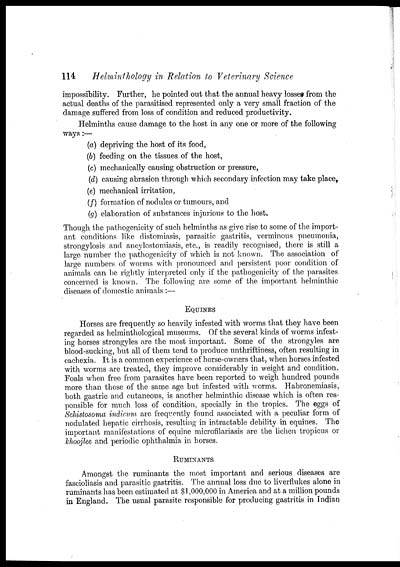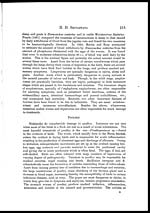Medicine - Veterinary > Veterinary colleges and laboratories > Indian journal of veterinary science and animal husbandry > Volume 8, 1938 > Original articles > Helminthology in relation to veterinary science
(128) Page 114
Download files
Individual page:
Thumbnail gallery: Grid view | List view

114 Helminthology in Relation to Veterinary Science
impossibility. Further, he pointed out that the annual heavy losses from the
actual deaths of the parasitised represented only a very small fraction of the
damage suffered from loss of condition and reduced productivity.
Helminths cause damage to the host in any one or more of the following
ways:—
(a) depriving the host of its food,
(b) feeding on the tissues of the host,
(c) mechanically causing obstruction or pressure,
(d) causing abrasion through which secondary infection may take place,
(e) mechanical irritation,
(f) formation of nodules or tumours, and
(g) elaboration of substances injurious to the host.
Though the pathogenicity of such helminths as give rise to some of the import-
ant conditions like distomiasis, parasitic gastritis, verminous pneumonia,
strongylosis and ancylostomiasis, etc., is readily recognised, there is still a
large number the pathogenicity of which is not known. The association of
large numbers of worms with pronounced and persistent poor condition of
animals can be rightly interpreted only if the pathogenicity of the parasites
concerned is known. The following are some of the important helminthic
diseases of domestic animals :—
EQUINES
Horses are frequently so heavily infested with worms that they have been
regarded as helminthological museums. Of the several kinds of worms infest-
ing horses strongyles are the most important. Some of the strongyles are
blood-sucking, but all of them tend to produce unthriftiness, often resulting in
cachexia. It is a common experience of horse-owners that, when horses infested
with worms are treated, they improve considerably in weight and condition.
Foals when free from parasites have been reported to weigh hundred pounds
more than those of the same age but infested with worms. Habronemiasis,
both gastric and cutaneous, is another helminthic disease which is often res-
ponsible for much loss of condition, specially in the tropics. The eggs of
Schistosoma indicum are frequently found associated with a peculiar form of
nodulated hepatic cirrhosis, resulting in intractable debility in equines. The
important manifestations of equine microfilariasis are the lichen tropicus or
khoojlee and periodic ophthalmia in horses.
RUMINANTS
Amongst the ruminants the most important and serious diseases are
fascioliasis and parasitic gastritis. The annual loss due to liverflukes alone in
ruminants has been estimated at $1,000,000 in America and at a million pounds
in England. The usual parasite responsible for producing gastritis in Indian
Set display mode to: Large image | Zoom image | Transcription
Images and transcriptions on this page, including medium image downloads, may be used under the Creative Commons Attribution 4.0 International Licence unless otherwise stated. ![]()
| Permanent URL | https://digital.nls.uk/75243885 |
|---|
| Description | Covers articles from 1938. |
|---|




